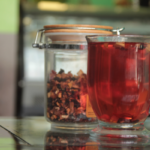I. Introduction
The popularity of tea has been steadily increasing, and it is now one of the most consumed beverages in the world. Tea is not only a delicious and refreshing drink, but it also has a rich historical and cultural significance. In this article, we will explore the process of tea production, from harvest to cup, and discover the steps that contribute to the unique flavors and aromas of different types of tea.
II. Harvesting Tea Leaves
The first step in the tea production process is the harvesting of tea leaves. This process involves carefully selecting the leaves that are at the ideal stage of growth. The timing of the harvest depends on the type of tea being produced. For example, green tea is often harvested when the leaves are young and tender, while black tea is harvested when the leaves have fully developed.
There are two main methods of harvesting tea leaves: manual and mechanical. Manual harvesting involves skilled workers carefully hand-picking the leaves, ensuring that only the best leaves are harvested. Mechanical harvesting, on the other hand, uses machines to strip the leaves from the tea bushes. While mechanical harvesting is more efficient, it may result in a lower quality of leaves due to the lack of human precision.
Quality is an essential factor in the tea industry, and the selection of high-quality tea leaves is crucial. Skilled workers carefully examine the leaves during the harvesting process, ensuring that only the finest leaves without blemishes or damage are included. The quality of the tea leaves directly affects the final flavor and aroma of the tea.
III. Withering and Rolling of Tea Leaves
After harvesting, the tea leaves go through a process called withering. Withering involves spreading the leaves out to reduce their moisture content. This process can take several hours to several days, depending on the desired outcome. The purpose of withering is to remove excess moisture from the leaves while allowing them to retain their flavor compounds.
Once the tea leaves have withered, they are ready for rolling. Rolling is a crucial step in tea production as it helps to release the essential oils from the leaves, adding complexity to the flavor profiles of the teas. Rolling is done by either machine or hand, with hand-rolling often being preferred for high-quality teas due to the greater control it offers.
The combined process of withering and rolling plays a significant role in the development of flavors and aromas in tea. This is why teas that go through this process, such as oolong tea, are known for their unique and complex profiles.
IV. Fermentation (or Oxidation) of Tea
Fermentation, also known as oxidation, is a critical step in the production of certain types of tea, such as black tea. Fermentation refers to the enzymatic reaction that occurs when the tea leaves are exposed to air. This reaction changes the chemical composition of the leaves, resulting in the distinctive dark color and bold flavors of black tea.
Different types of tea undergo varying degrees of fermentation. For example, green tea is not fermented at all, resulting in its light and fresh taste, while black tea is fully fermented, creating its robust and intense flavors. Oolong tea falls somewhere in between, undergoing partial fermentation to create its unique characteristics.
The duration of fermentation also affects the final characteristics of the tea. Shorter fermentation times result in lighter flavors, while longer fermentation times produce darker and more robust flavors. Tea producers carefully monitor the fermentation process to achieve the desired flavor profiles.
V. Drying Tea Leaves
After fermentation, the tea leaves are dried to halt the fermentation process and stabilize the flavor and aroma. There are several methods of drying tea leaves, including air drying, oven drying, and using special drying machines. The chosen method depends on the type of tea being produced and the desired outcome.
Proper drying is essential for the preservation of tea. It helps to remove any remaining moisture from the leaves, preventing the growth of mold or bacteria. Drying also enhances the shelf life of the tea, allowing it to be stored and enjoyed for a more extended period.
Correct drying techniques contribute to the quality of the final tea product. Tea that has been dried correctly will have a well-preserved aroma and a full-bodied flavor, providing a more satisfying tea-drinking experience.
VI. Sorting and Storing Tea
After the drying process, tea leaves are sorted based on their quality. Skilled workers carefully examine the leaves, categorizing them according to factors such as leaf size, color, and consistency. This sorting process ensures that only the highest quality leaves are used for the final tea product.
Proper storage is essential for maintaining the quality of tea. Tea leaves are highly sensitive to light, moisture, and odors, which can all alter the taste and aroma of the tea. To preserve the tea’s freshness, it should be stored in airtight containers away from direct sunlight and strong odors.
For those who enjoy brewing their tea at home, it is crucial to follow proper storage practices. Tea should be stored in a cool, dry place, away from any heat sources or moisture. Sealing the tea in an airtight container can help prolong its shelf life and maintain its quality over time.
VII. Preparation and Infusion
The preparation and infusion of tea are the final steps in the tea production process before it reaches your cup. Proper preparation ensures that you can fully appreciate the flavors and aromas of the tea. Depending on the type of tea, different brewing times and water temperatures are recommended.
For example, green tea is best brewed with water at around 175°F (80°C) and steeped for 2-3 minutes, while black tea is typically brewed with boiling water and steeped for 3-5 minutes. Following these guidelines allows for optimal extraction of flavors and ensures a well-balanced cup of tea.
During the infusion process, it is essential to carefully observe the tea’s color, aroma, and taste. The color of the tea should be vibrant, and the aroma should be inviting. Take the time to savor the flavors and notes of the tea, noticing any subtleties or complexities that make each variety unique.
VIII. Conclusion
The journey from harvest to cup involves several essential steps that contribute to the creation of a delightful tea-drinking experience. From carefully selecting the finest tea leaves to properly drying and storing them, each stage has an impact on the final taste and quality of the tea.
Understanding and appreciating the tea production process allows us to gain a deeper appreciation for this ancient beverage. Tea has a rich cultural and historical significance, and it is a fascinating exploration of flavors and aromas from around the world.
So, the next time you steep a cup of tea, take a moment to reflect on the intricate process it underwent to reach your hands. Savor its flavors, enjoy its aromas, and remember the journey it took from the tea gardens to your cup. Cheers to the wonderful world of tea!






